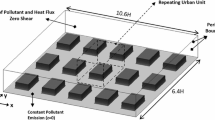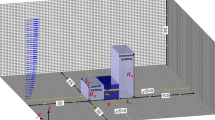Abstract
Urban surface and radiation processes are incorporated into a computational fluid dynamics (CFD) model to investigate the diurnal variation of flow in a street canyon with an aspect ratio of 1. The developed CFD model predicts surface and substrate temperatures of the roof, walls, and road. One-day simulations are performed with various ambient wind speeds of 2, 3, 4, 5, and 6 ms−1, with the ambient wind perpendicular to the north–south oriented canyon. During the day, the largest maximum surface temperature for all surfaces is found at the road surface for an ambient wind speed of 3 ms−1 (56.0°C). Two flow regimes are identified by the vortex configuration in the street canyon. Flow regime I is characterized by a primary vortex. Flow regime II is characterized by two counter-rotating vortices, which appears in the presence of strong downwind building-wall heating. Air temperature is relatively low near the downwind building wall in flow regime I and inside the upper vortex in flow regime II. In flow regime II, the upper vortex expands with increasing ambient wind speed, thus enlarging the extent of cool air within the canyon. The canyon wind speed in flow regime II is proportional to the ambient wind speed, but that in flow regime I is not. For weak ambient winds, the dependency of surface sensible heat flux on the ambient wind speed is found to play an essential role in determining the relationship between canyon wind speed and ambient wind speed.
Similar content being viewed by others
References
Baik JJ, Kang YS, Kim JJ (2007) Modeling reactive pollutant dispersion in an urban street canyon. Atmos Environ 41: 934–949
Chen H, Ooka R, Harayama K, Kato S, Li X (2004) Study on outdoor thermal environment of apartment block in Shenzhen, China with coupled simulation of convection, radiation and conduction. Energy Build 36: 1247–1258
Cheng WC, Liu CH, Leung DYC (2009) On the correlation of air and pollutant exchange for street canyons in combined wind-buoyancy-driven flow. Atmos Environ 43: 3682–3690
Eliasson I, Offerle B, Grimmond CSB, Lindqvist S (2006) Wind fields and turbulence statistics in an urban street canyon. Atmos Environ 40: 1–16
Hadavand M, Yaghoubi M, Emdad H (2008) Thermal analysis of vaulted roof. Energy Build 40: 265–275
Harman IN, Belcher SE (2006) The surface energy balance and boundary layer over urban street canyons. Q J Roy Meteorol Soc 132: 2749–2768
Idczak M, Mestayer P, Rosant JM, Sini JF, Violleau MV (2007) Micrometeorological measurements in a street canyon during the joint ATREUS-PICADA experiment. Boundary-Layer Meteorol 124: 25–41
Idczak M, Groleau D, Mestayer P, Rosant JM, Sini JF (2010) An application of the thermo-radiative model SOLENE for the evaluation of street canyon energy balance. Build Environ 45: 1262–1275
Kang YS, Baik JJ, Kim JJ (2008) Further studies of flow and reactive pollutant dispersion in a street canyon with bottom heating. Atmos Environ 42: 4964–4975
Kim JJ, Baik JJ (1999) A numerical study of thermal effects on flow and pollutant dispersion in urban street canyons. J Appl Meteorol 38: 1249–1261
Kim JJ, Baik JJ (2001) Urban street-canyon flows with bottom heating. Atmos Environ 35: 3395–3404
Kim JJ, Baik JJ (2004) A numerical study of the effects of ambient wind direction on flow and dispersion in urban street canyons using the RNG k–\({\varepsilon}\) turbulence model. Atmos Environ 38: 3039–3048
Kovar-Panskus A, Moulinneuf L, Savory E, Abdelqari A, Sini JF, Rosant JM, Robins A, Toy N (2002) A wind tunnel investigation of the influence of solar-induced wall-heating on the flow regime within a simulated urban street canyon. Water Air Soil Pollut Focus 2: 555–571
Lee SH, Park SU (2008) A vegetated urban canopy model for meteorological and environmental modeling. Boundary-Layer Meteorol 126: 73–102
Li XX, Liu CH, Leung DYC, Lam KM (2006) Recent progress in CFD modeling of wind field and pollutant transport in street canyons. Atmos Environ 40: 5640–5658
Louka P, Vachon G, Sini JF, Mestayer PG, Rosant JM (2002) Thermal effects on the flow in a street canyon—Nantes’99 experimental results and model simulations. Water Air Soil Pollut Focus 2: 351–364
Nakamura Y, Oke TR (1988) Wind, temperature and stability conditions in an east-west oriented urban canyon. Atmos Environ 22: 2691–2700
Offerle B, Eliasson I, Grimmond CSB, Holmer B (2007) Surface heating in relation to air temperature, wind and turbulence in an urban street canyon. Boundary-Layer Meteorol 122: 273–292
Panão MJN, Gonçalves HJP, Ferrão PMC (2007) A matrix approach coupled with Monte Carlo techniques for solving the net radiative balance of the urban block. Boundary-Layer Meteorol 122: 217–241
Panão MJN, Gonçalves HJP, Ferrão PMC (2009) Numerical analysis of the street canyon thermal conductance to improve urban design and climate. Build Environ 44: 177–187
Ryu YH, Baik JJ, Lee SH (2011) A new single-layer urban canopy model for use in mesoscale atmospheric models. J Appl Meteorol Clim (in press)
Santamouris M, Papanikolaou N, Koronakis I, Livada I, Asimakopoulos D (1999) Thermal and air flow characteristics in a deep pedestrian canyon under hot weather conditions. Atmos Environ 33: 4503–4521
Sini JF, Anquetin S, Mestayer PG (1996) Pollutant dispersion and thermal effects in urban street canyons. Atmos Environ 30: 2659–2677
Swinbank WC (1963) Long-wave radiation from clear skies. Q J Roy Meteorol Soc 89: 339–348
Tsai MY, Chen KS, Wu CH (2005) Three-dimensional modeling of air flow and pollutant dispersion in an urban street canyon with thermal effects. J Air Waste Manag Assoc 55: 1178–1189
Uehara K, Murakami S, Oikawa S, Wakanatsu S (2000) Wind tunnel experiments on how thermal stratification affects flow in and above urban street canyons. Atmos Environ 34: 1553–1562
Versteeg HK, Malalasekera W (1995) An introduction to computational fluid dynamics: the finite volume method. Longman, Malaysia, 272 pp
Xie X, Huang Z, Wang J, Xie Z (2005) The impact of solar radiation and street layout on pollutant dispersion in street canyon. Build Environ 40: 201–212
Author information
Authors and Affiliations
Corresponding author
Rights and permissions
About this article
Cite this article
Kwak, KH., Baik, JJ., Lee, SH. et al. Computational Fluid Dynamics Modelling of the Diurnal Variation of Flow in a Street Canyon. Boundary-Layer Meteorol 141, 77–92 (2011). https://doi.org/10.1007/s10546-011-9630-4
Received:
Accepted:
Published:
Issue Date:
DOI: https://doi.org/10.1007/s10546-011-9630-4




